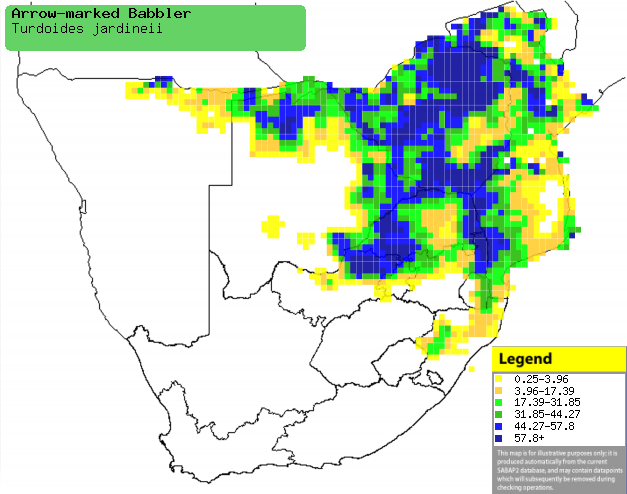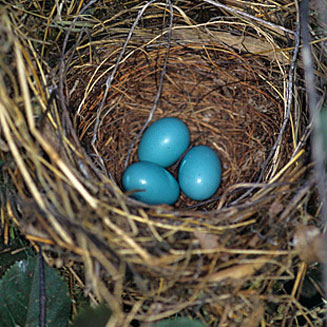|
Turdoides jardineii (Arrow-marked
babbler)
Pylvlekkatlagter [Afrikaans]; iHelkehle [Zulu]; Siwerewere
(generic term for babbler) [Kwangali]; Dywedywe, Hochahocha [Shona];
Inhlekabafazi (in Zulu this name is applied to Green wood-hoopoe) [Swazi];
Tlekedhwana [Tsonga]; Letshêganôga [Tswana]; Pijlpuntbabbelaar [Dutch];
Cratérope fléché [French]; Braundroßling [German];
Zaragateiro-castanho [Portuguese]
Life
> Eukaryotes >
Opisthokonta
> Metazoa (animals) >
Bilateria >
Deuterostomia > Chordata >
Craniata > Vertebrata (vertebrates) > Gnathostomata (jawed
vertebrates) > Teleostomi (teleost fish) > Osteichthyes (bony fish) > Class:
Sarcopterygii (lobe-finned
fish) > Stegocephalia (terrestrial
vertebrates) > Tetrapoda
(four-legged vertebrates) > Reptiliomorpha > Amniota >
Reptilia (reptiles) >
Romeriida > Diapsida > Archosauromorpha > Archosauria >
Dinosauria
(dinosaurs) > Saurischia > Theropoda (bipedal predatory dinosaurs) >
Coelurosauria > Maniraptora > Aves
(birds) >
Order: Passeriformes > Family: Sylviidae
> Genus: Turdoides
Distribution and habitat
Occurs from Uganda through Angola, Tanzania, northern
Mozambique and Zambia to southern Africa. Here it is locally common, preferring
clumps of bushes and thickets amongst termite mounds in moist savanna woodland.
It also occupies dry riverine woodland, disturbed woodland with dense grass
(typically on the border of farmland), reedbeds, alien tree plantations and farm
and suburban gardens.
|
 |
|
Distribution of Arrow-marked babbler in southern Africa,
based on statistical smoothing of the records from first SA Bird Atlas
Project (©
Animal Demography unit, University of
Cape Town; smoothing by Birgit Erni and Francesca Little). Colours range
from dark blue (most common) through to yellow (least common).
See here for the latest distribution
from the SABAP2. |
Predators and parasites
Brood parasites
It has been recorded as host of the
Levaillant's cuckoo.
Food
It mainly eats invertebrates, doing most of its foraging in
groups on the ground and in the undergrowth, flicking through leaf litter and
gleaning from leaves and branches. The following food items have been recorded
in its diet:
- Invertebrates
- Plants
- seeds
- fruit up to the size of the loquat
- nectar
- Aloe marlothii (Mountain aloe)
- Aloe greatheadii (Spotted aloe)
Breeding
- It is a cooperative breeder, building a messy cup (see image below) of
twigs, dry grass, plant stems and leaf petioles lined with finer material.
It is typically placed in the dense foliage of a tree, bush, pile of
driftwood, reedbed or a cavity in a dead tree.
 |
|
|
Arrow-marked babbler nest with eggs, Sericea
farm, South Africa. [photo Warwick Tarboton ©] |
|
- Egg-laying season is year round, peaking around September-April.
- It lays 2-5, usually 3 eggs, which are incubated by all group members
for about 13-17 days.
- The chicks are cared for and protected by all group members, leaving the
nest after about 18-21 days. They tend leave earlier if the group size is
larger.
Threats
Not threatened.
References
-
Hockey PAR, Dean WRJ and Ryan PG 2005. Roberts
- Birds of southern Africa, VIIth ed. The Trustees of the John Voelcker
Bird Book Fund, Cape Town.
-
Harrison, J.A., Allan, D.G., Underhill, L.G., Herremans, M.,
Tree. A.J., Parker, V. & Brown, C.J. (eds). 1997. The atlas of southern
African birds. Vol. 2: Passerines. BirdLife South Africa, Johannesburg.
|
